Camshaft Installation Left
Tools Required
| • | J 43032 Crankshaft
Rotation Socket |
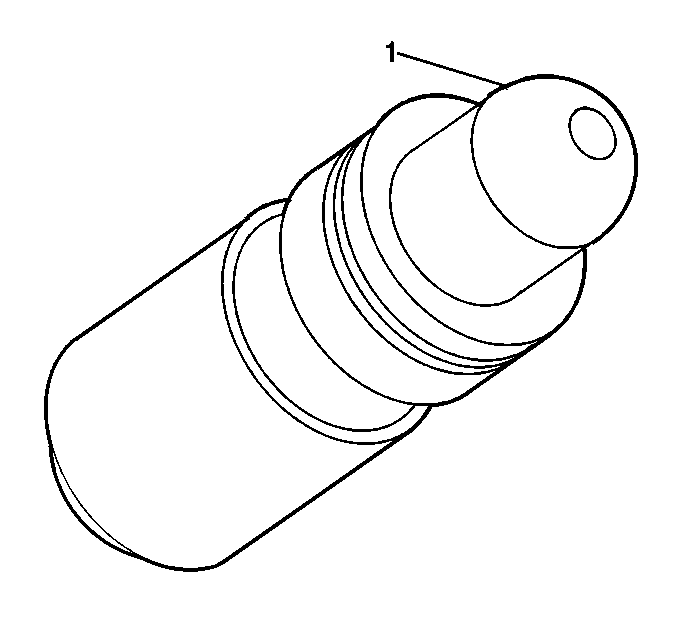
Important: Do not stroke/cycle the stationary hydraulic lash adjuster plunger without
oil in the lower pressure chamber.
Important: Do not allow the stationary hydraulic lash adjuster to tip over (plunger
down) after the oil fill.
- Fill the stationary hydraulic lash adjuster (SHLA) with clean engine
oil GM P/N 12378006 or equivalent. Take precautions to prevent
scratching the pivot sphere area (1) of the SHLA.
- Lubricate the SHLA bores in the cylinder head with clean engine
oil GM P/N 12378006 or equivalent.

- Install the SHLAs in the
cylinder head.
- Apply a liberal amount of lubricant GM P/N 12345501
or equivalent to the SHLA pivot spheres.
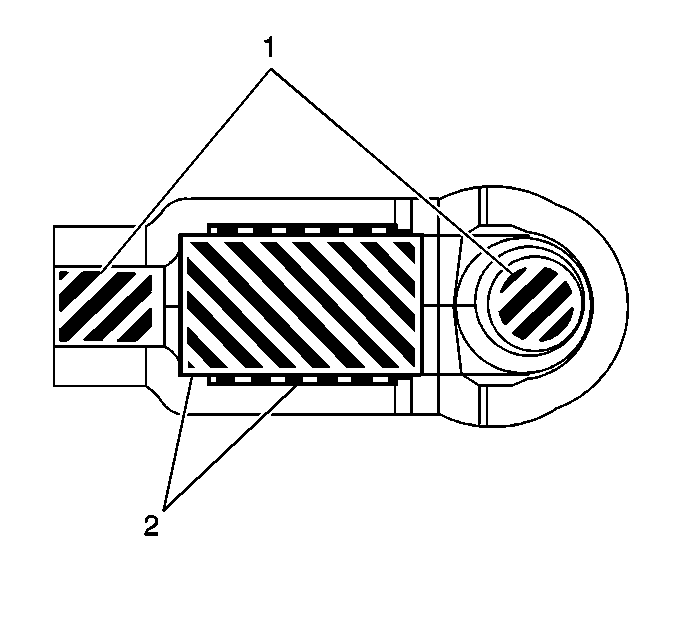
- Apply a liberal amount
of lubricant GM P/N 12345501 or equivalent to the roller (2),
pivot pocket and valve slot areas (1) of the camshaft followers.
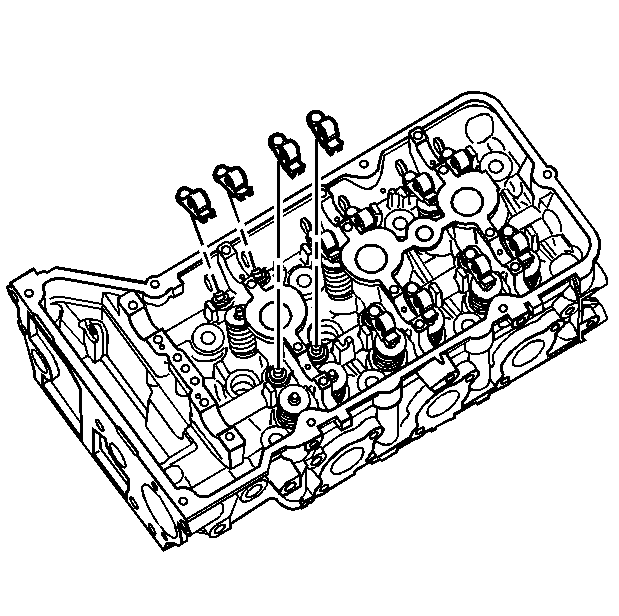
Important: The follower must be positioned squarely on the valve tip so that the
full width of the roller will completely contact the camshaft lobe. If the
followers are being reused you must put them back in their original location.
- Place the camshaft followers in position on the valve tip and SHLA.
The rounded head end of the follower goes on the SHLA while the flat end goes
on the valve tip.
- Clean the camshaft journals and carriers with a clean, lint-free
cloth.
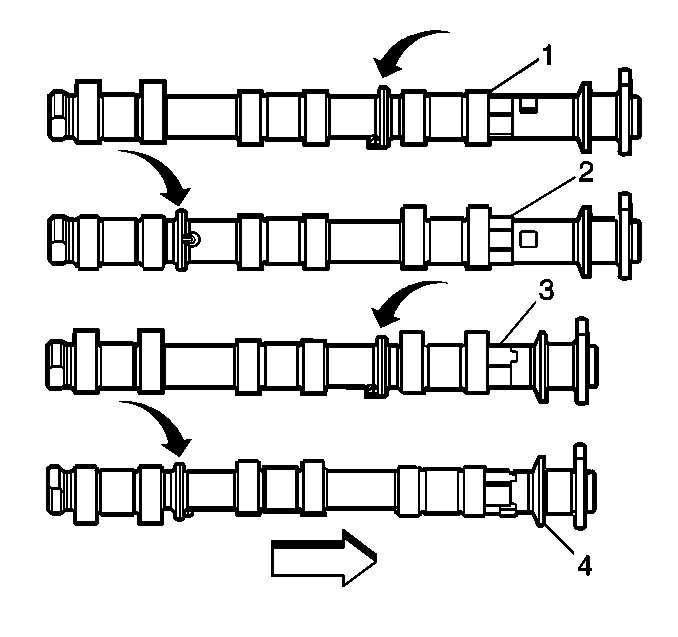
Important: Ensure that the crankshaft is in the TDC position using the J 43032
.
- Select the proper camshaft for the particular installation location.
The left cylinder head camshafts (1 & 2) are longer than those for the
right cylinder head (3 & 4). However, both sets of camshafts share the
same placement of identification rings. The ring placement is defined as
follows:
| 8.1. | The identification ring for the intake camshafts (1 & 3) is
located between the first and second sets of lobes. |
| 8.2. | The identification ring for the exhaust camshafts (2 & 4)
is located between the second and third sets of lobes. |
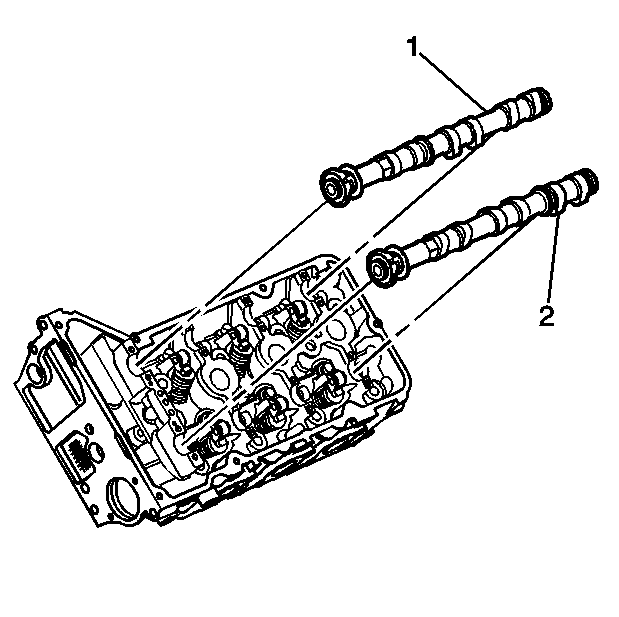
- Apply a liberal amount
of lubricant GM P/N 12345501 or equivalent to the camshaft journals
and the cylinder head camshaft carriers.
- Place the intake (1) and exhaust (2) camshafts in position in
the cylinder head.
- Position the camshaft lobes in a neutral position with the front
notch for the camshaft sprocket drive pins near the top of their rotation
and the rear flats of the camshaft near the installation position of the J 42038
.
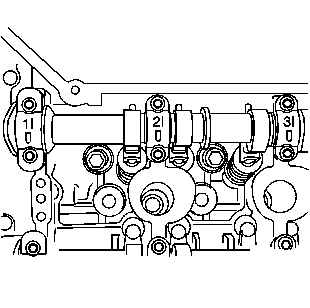
- Observe the markings on
the bearing caps. Each bearing cap is marked in order to identify its location.
The markings have the following meanings:
| • | The raised feature must always be oriented toward the outboard
side of the engine. |
| • | The I indicates the intake camshaft. |
| • | The E indicates the exhaust camshaft. |
| • | The number indicates the journal position from the front of the
engine. |
- Apply a liberal amount of lubricant GM P/N 12345501
or equivalent to the camshaft bearing caps.
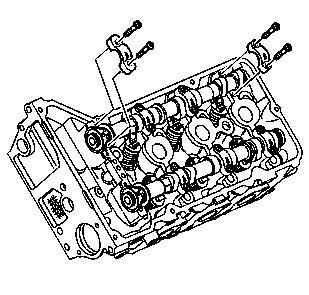
- Install the camshaft bearing
thrust caps in the first journal of each camshaft. The thrust caps are wider
than the others and have machined undercuts not present on the other caps.
Ensure that the orientation marking is closest to the engine outboard side.
- Install the remaining bearing caps with their orientation mark
closest to the engine outboard side.
- Hand start all the camshaft bearing cap bolts.
Notice: Use the correct fastener in the correct location. Replacement fasteners
must be the correct part number for that application. Fasteners requiring
replacement or fasteners requiring the use of thread locking compound or sealant
are identified in the service procedure. Do not use paints, lubricants, or
corrosion inhibitors on fasteners or fastener joint surfaces unless specified.
These coatings affect fastener torque and joint clamping force and may damage
the fastener. Use the correct tightening sequence and specifications when
installing fasteners in order to avoid damage to parts and systems.
- Tighten the camshaft
bearing caps.
Tighten
- Tighten the camshaft bearing cap bolts to 8 N·m (71 lb in).
- Tighten the camshaft bearing cap bolts an additional 22 degrees
using theJ 36660-A
.

Important: There should be no need to rotate the camshaft more then 10 degrees.
- Using the hex cast into the camshaft, rotate the camshaft so the rear
camshaft flat is facing the cylinder head in order to install the J 42038
.
- Install the J 42038
at the rear of the cylinder head.
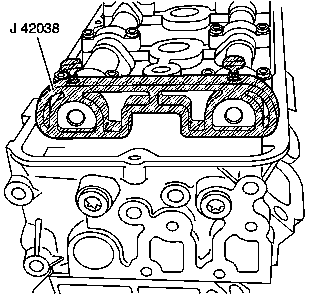
Important: All camshafts must be locked in place before installation of the secondary
timing chains.
- Ensure that the J 42038
is fully seated and locked onto the camshafts.
Camshaft Installation Right
Tools Required
| • | J 43032 Crankshaft
Rotation Socket |

Important: Do not stroke/cycle the stationary hydraulic lash adjuster plunger without
oil in the lower pressure chamber.
Important: Do not allow the stationary hydraulic lash adjuster to tip over (plunger
down) after the oil fill.
- Fill the stationary hydraulic lash adjuster (SHLA) with clean engine
oil GM P/N 12378006 or equivalent. Take precautions to prevent
scratching the pivot sphere area (1) of the SHLA.
- Lubricate the SHLA bores in the cylinder head with clean engine
oil GM P/N 12378006 or equivalent.
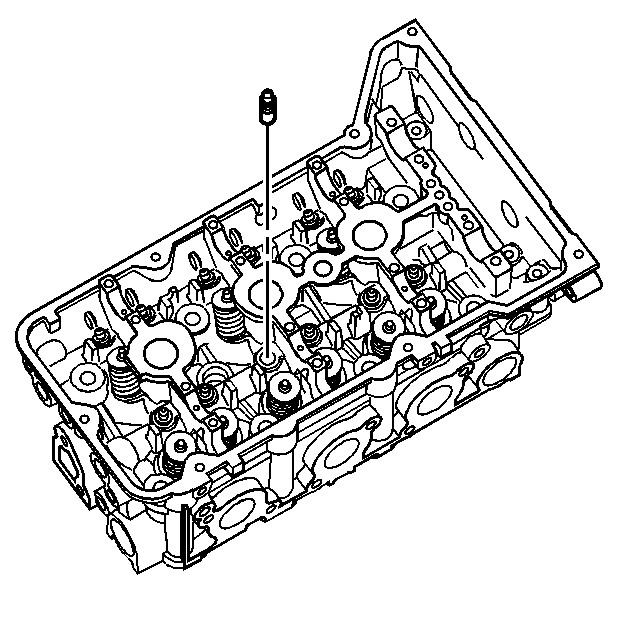
- Install the SHLAs in the
cylinder head.
- Apply a liberal amount of lubricant GM P/N 12345501
or equivalent to the SHLA pivot spheres.

- Apply a liberal amount
of lubricant GM P/N 12345501 or equivalent to the roller (2),
pivot pocket and valve slot areas (1) of the camshaft followers.
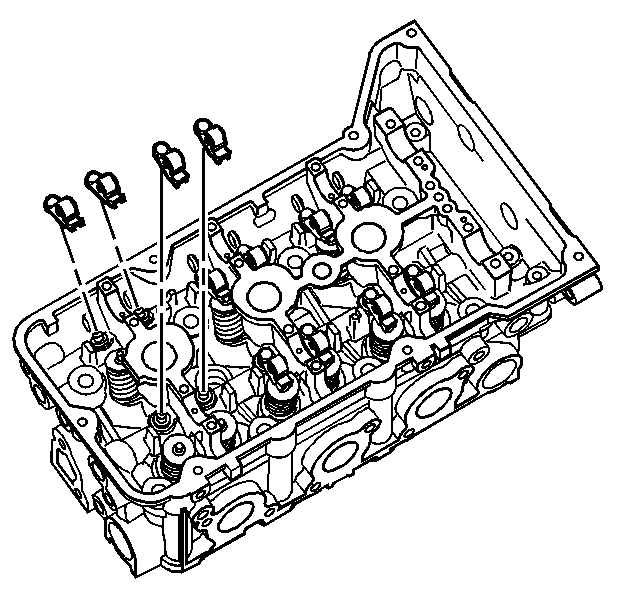
Important: The follower must be positioned squarely on the valve tip so that the
full width of the roller will completely contact the camshaft lobe. If the
followers are being reused you must put them back in their original location.
- Place the camshaft followers in position on the valve tip and SHLA.
The rounded head end of the follower goes on the SHLA while the flat end goes
on the valve tip.
- Clean the camshaft journals and carriers with a clean, lint-free
cloth.

Important: Ensure that the crankshaft is in the TDC position using the J 43032
.
- Select the proper camshaft for the particular installation location.
The left cylinder head camshafts (1 & 2) are longer than those for the
right cylinder head (3 & 4). However, both sets of camshafts share the
same placement of identification rings. The ring placement is defined as
follows:
| 8.1. | The identification ring for the intake camshafts (1 & 3) is
located between the first and second sets of lobes. |
| 8.2. | The identification ring for the exhaust camshafts (2 & 4)
is located between the second and third sets of lobes. |
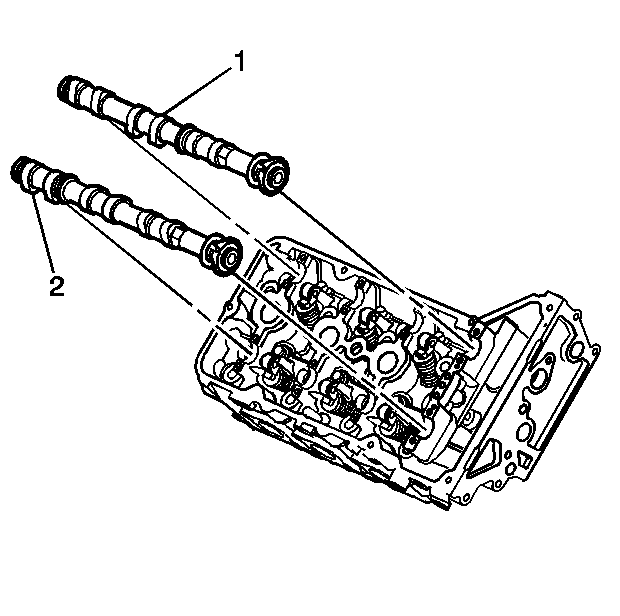
- Apply a liberal amount
of lubricant GM P/N 12345501 or equivalent to the camshaft journals
and the cylinder head camshaft carriers.
- Place the intake (1) and exhaust (2) camshafts in position in
the cylinder head.
- Position the camshaft lobes in a neutral position with the front
notch for the camshaft sprocket drive pins near the top of their rotation
and the rear flats of the camshaft near the installation position of the J 42038
.
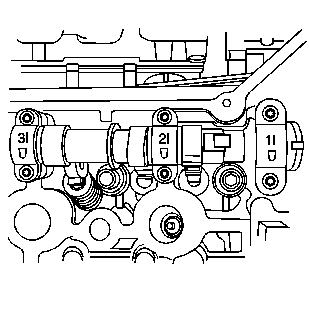
- Observe the markings on
the bearing caps. Each bearing cap is marked in order to identify its location.
The markings have the following meanings:
| • | The raised feature must always be oriented toward the outboard
side of the engine. |
| • | The I indicates the intake camshaft. |
| • | The E indicates the exhaust camshaft. |
| • | The number indicates the journal position from the front of the
engine. |
- Apply a liberal amount of lubricant GM P/N 12345501
or equivalent to the camshaft bearing caps.

- Install the camshaft bearing
thrust caps in the first journal of each camshaft. The thrust caps are wider
than the others and have machined undercuts not present on the other caps.
Ensure that the orientation marking is closest to the engine outboard side.
- Install the remaining bearing caps with their orientation mark
closest to the engine outboard side.
- Hand start all the camshaft bearing cap bolts.
Notice: Use the correct fastener in the correct location. Replacement fasteners
must be the correct part number for that application. Fasteners requiring
replacement or fasteners requiring the use of thread locking compound or sealant
are identified in the service procedure. Do not use paints, lubricants, or
corrosion inhibitors on fasteners or fastener joint surfaces unless specified.
These coatings affect fastener torque and joint clamping force and may damage
the fastener. Use the correct tightening sequence and specifications when
installing fasteners in order to avoid damage to parts and systems.
- Tighten the camshaft
bearing caps.
Tighten
- Tighten the camshaft bearing cap bolts to 8 N·m (71 lb in).
- Tighten the camshaft bearing cap bolts an additional 22 degrees
using theJ 36660-A
.

Important: There should be no need to rotate the camshaft more then 10 degrees.
- Using the hex cast into the camshaft, rotate the camshaft so the rear
camshaft flat is facing the cylinder head in order to install the J 42038
.
- Install the J 42038
at the rear of the cylinder head.
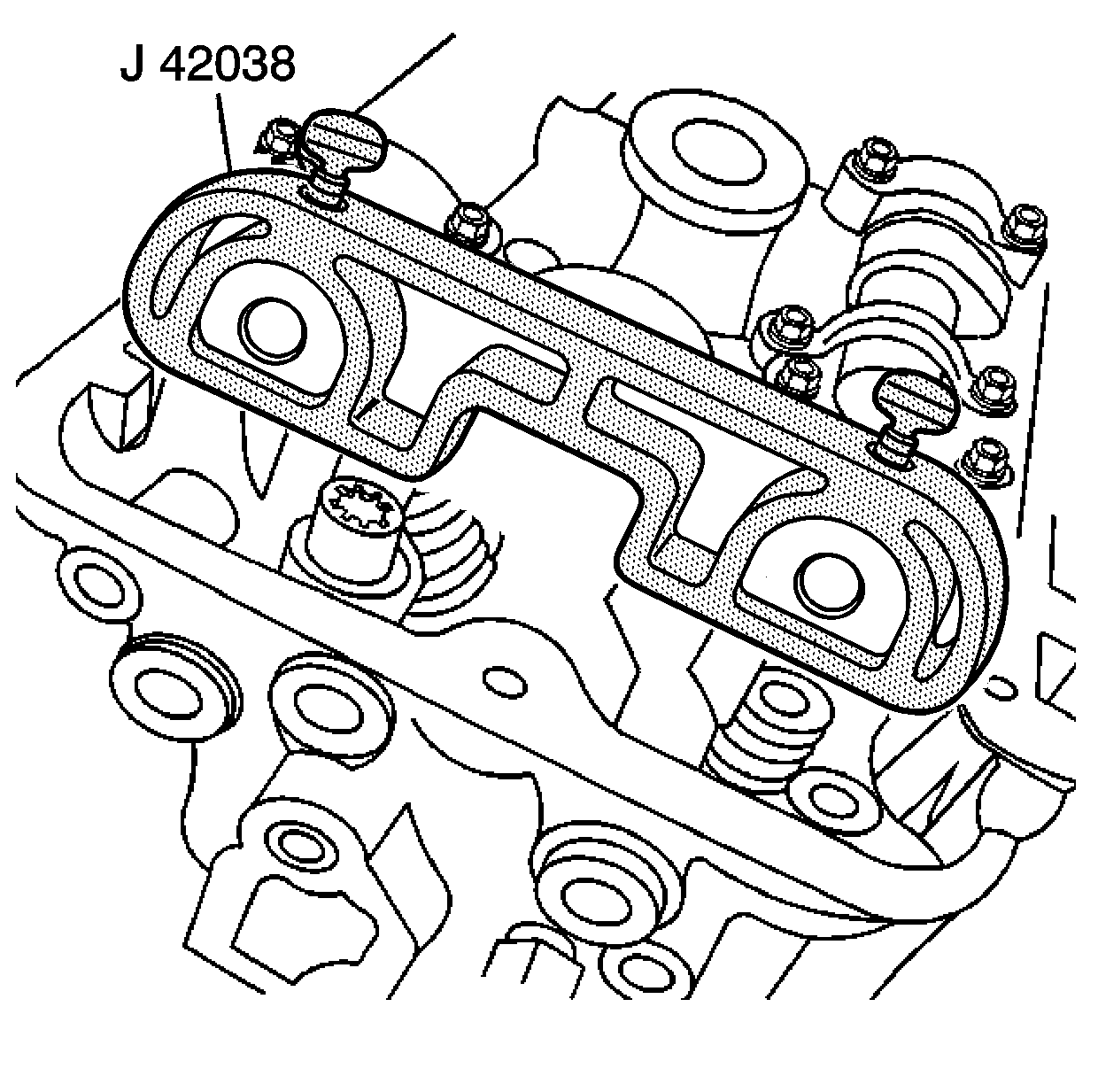
Important: All camshafts must be locked in place before installation of the secondary
timing chains.
- Ensure that the J 42038
is fully seated and locked onto the camshafts.




















